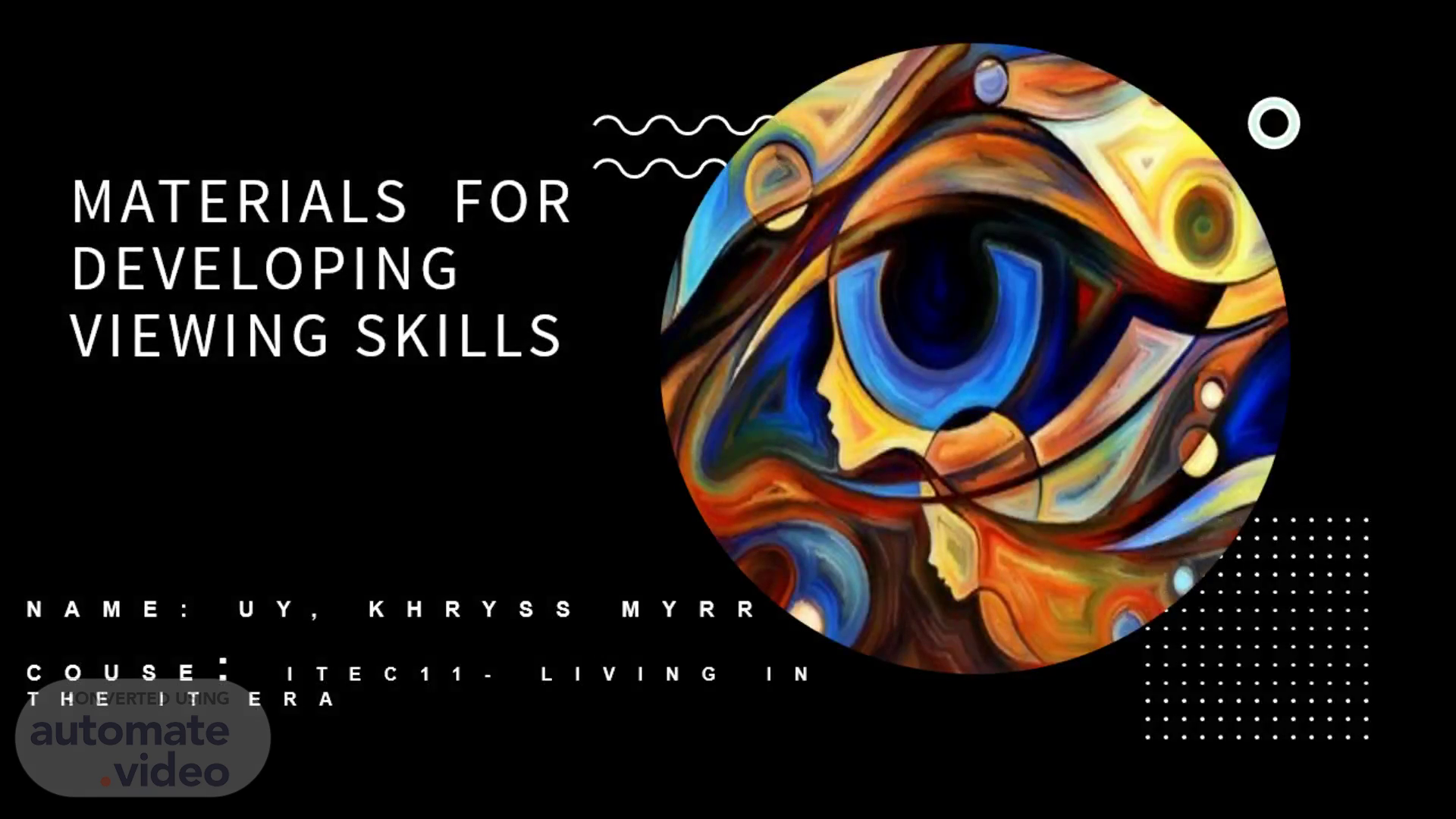
NAME: UY, KHRYSS MYRR COUSE: ITEC11- LIVING IN THE IT ERA
Scene 1 (0s)
NAME: UY, KHRYSS MYRR COUSE : ITEC11- LIVING IN THE IT ERA.
Scene 2 (11s)
Introduction. The inclusion of viewing as a language macroskills is due to the dominance of visual media. Kress (2010) defined multimodal text as those where the meanings are communicated by more than one mode. Ex. Still or moving pictures, written text, gestures, use of space, etc. There are also digital multimodal texts like e-posters, videos, digital stories, slideshows and web pages that may include hyperlinks, while th eatre , storytelling and dance can be classified as live multimodal texts..
Scene 3 (37s)
MATERIALS FOR DEVELOPING VIEWING SKILLS. 3. Teachers are at the forefront in attaining DepEd’s goal of producing graduates equipped with 21 st Century skills including ICT skills. Barrot (2016) concurred that these skills need to be taught as students are exposed to multimedia every single day. With the right teaching pedagogy coupled with relevant materials, teachers can help student think about the images they are seeing, train them on how to analyze and evaluate texts which are multimodal in nature. Donaghy (2019) succinctly explained what viewing is, why it’s important and how you can implement it in the classroom maintaining that it is about reading, analyzing, evaluating and appreciating , visual texts and images..
Scene 4 (1m 6s)
MATERIALS FOR DEVELOPING VIEWING SKILLS. 4. A number of the texts our students access within and outside the classroom and at home are visual and multimodal texts which use images. As part of the integrated language arts program, viewing supports oracy and literacy, thus students need to understand that viewing process is as important as understanding the listening and reading process. Distinct steps before, during and after viewing. Teachers: begin by asking students to look quietly for a moment at the work of art; open the discussion with questions that allow students to make them share multiple observations, inferences and interpretations; Ask the students to support their observations, inferences and interpretations by citing evidences Can ask more leading questions; Can ask whether new information can affect their interpretations; and Ask the students to summarize the discussion..
Scene 5 (1m 40s)
MATERIALS FOR DEVELOPING VIEWING SKILLS. 5. Language teachers provide assistance to their students as they construct meaning through creating or adopting materials that require the latter to analyze, infer, evaluate visual images. In the process, teachers serve as facilitator s and initiators of discussion as they recap observations, model vocabulary and generate additional thoughts..
Scene 6 (1m 56s)
MATERIALS FOR DEVELOPING VIEWING SKILLS. 6. Pre-Viewin Prepare to view. Acknowledge what is known and need to be known about the • topic. Prepare questions viewing. guide • before • Identify the goal for each type of viewing. While Viewin Predict the message and meaning. Connect what is being said with personal experience and make associations. the main Determine point/s. • Take down notes when necessary Differentiate between fact • and the message that lie beneath visuals and between real or imaginary images. • Post-Viewin Organize and summarize key points and important details. Associate what was viewed with one's experience or needs. Evaluate what was seen. Arrive at conclusions based on the details shown. Justify personal reactions or opinions of the presentation. • Identify the techniques used to influence the audience. Look for other information from various sources as needed or desired..
Scene 7 (2m 25s)
Critical Viewing. Messaris (1994) in Leonardo (1996) identify four aspects: Comprehension of visual media requires visual literacy. Visual literacy has general cognitive significances. Viewers have to be conscious of the skills required for visual manipulation. Aesthetic appreciation necessitates visual literacy..
Scene 8 (2m 41s)
MATERIALS FOR DEVELOPING VIEWING SKILLS. 8. To help students acquire critical viewing skills, teachers may provide, aside from authentic materials, some worksheets and activities. Samples of these are the following: Cloze Activities. Cloze tests are done when words or phrases are omitted from the text read or material viewed. The task of the students is to fill in the missing word/s and phrase/s after listening or viewing. Fact and Opinion Chart Fact and opinion chart is used when teachers want their students to identify and distinguish between fact and opinion. In the chart, the main topic or subject is written on top, the facts on and opinions are placed on the right column..
Scene 9 (3m 11s)
Graphic Organizers Graphic organizers are of varied styles and formats depending the purpose, nature of the material and information required. Picture Description Frame The prompts are written in the frame while the picture is placed at the center of the frame. Picture Book Studies The teacher selects various picture books or illustrations for viewing. Elements and interesting details pertaining to the pictures will be discussed such as the author’s style and artwork. Puppet Plays Students may watch or perform puppet shows using the target language. Puppet plays are powerful vehicles foe developing students’ critical viewing skills..
Scene 10 (3m 39s)
MATERIALS FOR DEVELOPING VIEWING SKILLS. 10. Film Viewing Films help students analyze the visual texts that they experience outside the classroom. They extend students’ vocabulary and experiences as they associate what has been seen with their personal stories. Talking Chips S tudents talk about the materials shown. Pause Button Teachers can use the “pause function” in a video and encourage students to share their predictions and their “what ifs” and critically evaluate key points shown in the video clip..
Scene 11 (4m 1s)
THANK YOU. MATERIALS FOR DEVELOPING VIEWING SKILLS.